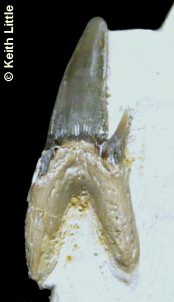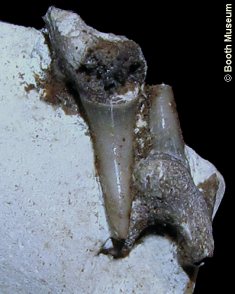 A A |
 B B |
 C C |
|
EOPTOLAMNIDS |
The extinct Eoptolamnids are the most ancient recognised Lamniforms, entering the fossil record in the Barremian. They possess medium to small tearing teeth, isolated examples of which are occasionally encountered in the Chalk. Characteristics of the teeth include a tall, slender main cusp with a convex lingual surface, sided by a pair of narrow accessory cusps. The lower part of the cusps is often ornamented with medium to fine ridges. Root halves are narrow and pronounced, with a narrow and deeply incised basal notch. There is a highly pronounced lingual protrusion.
 A A |
 B B |
 C C |
1). (A, B) Leptostyrax / Protolamna sp. - (A) Labial and (B) side views of a slightly damaged tooth (an accessory cusp missing), displaying the characteristic prominent lingual protrusion and pronounced root halves. Note narrow, pointed accessory cusps, fine striations at the base of the labial face of the main cusp, and the highly convex lingual surface of the main cusp (x4.2, Seaford Chalk, Dumpton Gap, near Broadstairs, Kent, Keith Little Collection, by kind permission); (C) Leptostyrax sp. - Side view of another damaged tooth (x5.5, Willett Collection, Booth Museum, BMB 007319, by kind permission of John Cooper).

2). Leptostyrax / Protolamna sp., Lingual surfaces of a pair of small associated teeth (x5.3, Booth Museum, by kind permission of John Cooper).